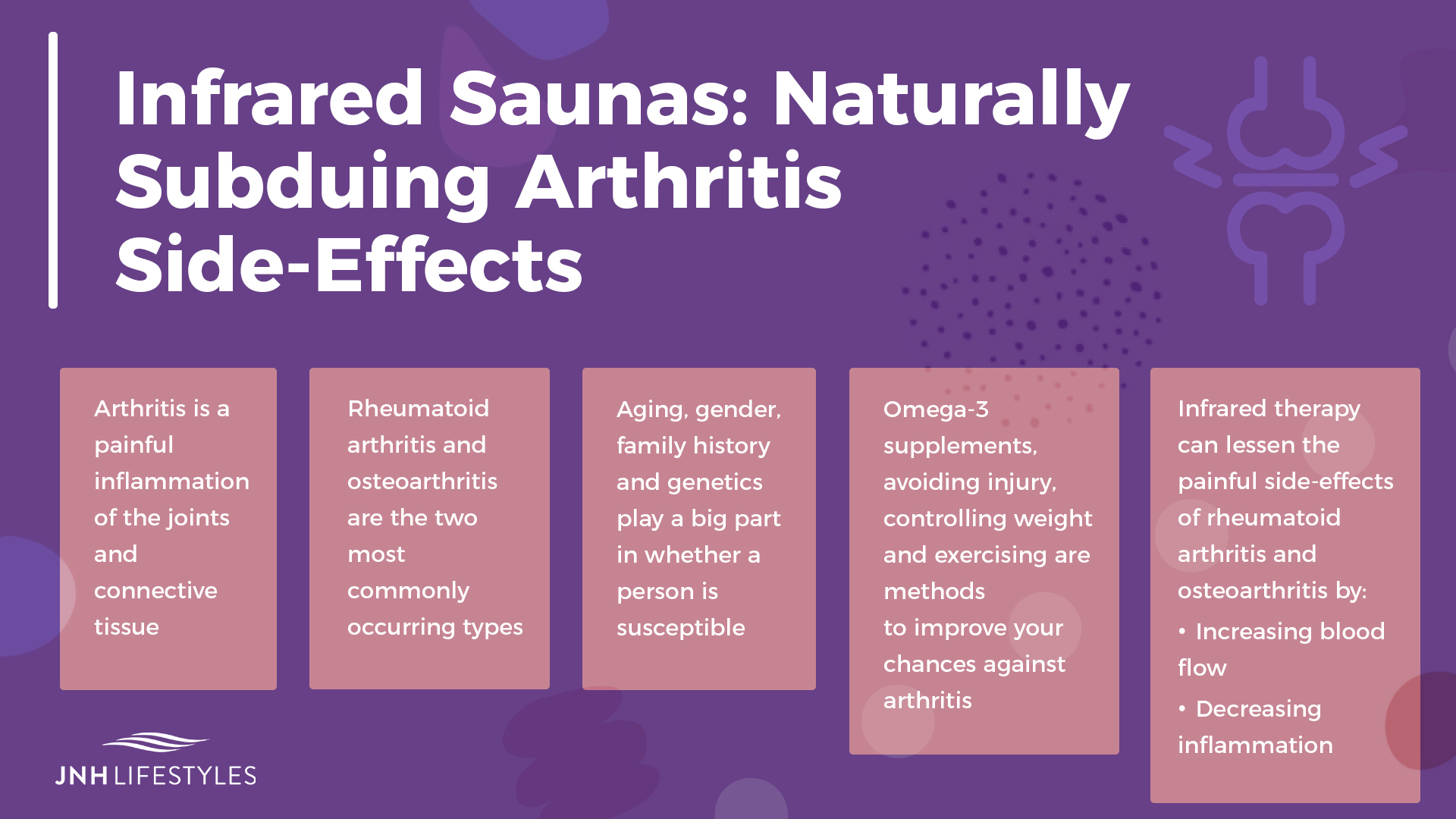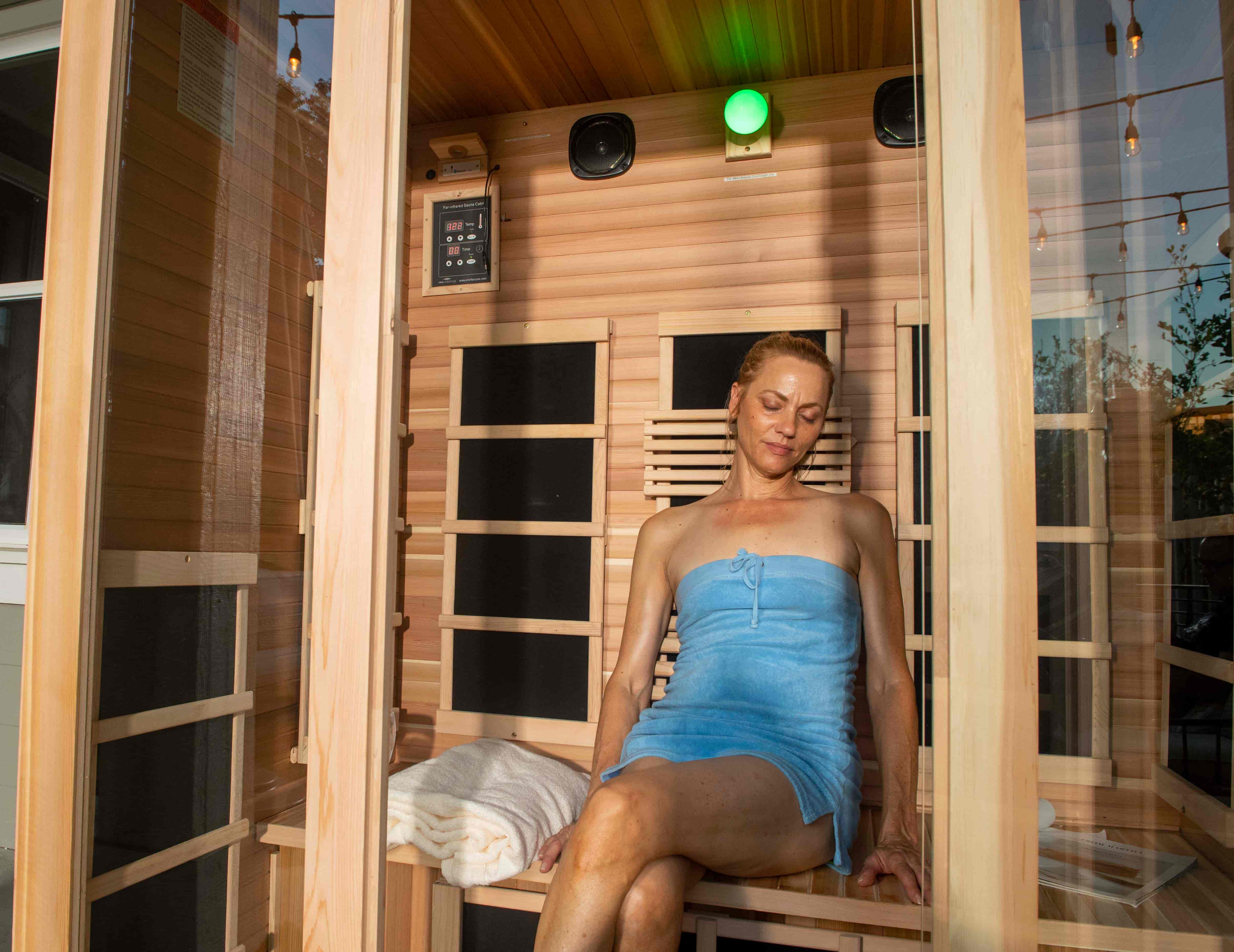The Debilitating Effects of Arthritis: What Sufferers Are Using to Combat This Common Disease
There are many debilitating diseases affecting millions of people, and arthritis is among one of the top offenders. In Australia alone, over 3.6 million people suffer from osteoarthritis, rheumatoid arthritis, and 'other type and unknown.' This chronic disease limits people’s ability to work, function, and do everyday things, like shopping, cooking, brushing their teeth, virtually anything that requires some kind of movement.
While no cure will rid sufferers completely of this disease, there are ways to make life more bearable and less painful. One of the ways to do that is through the regular use of infrared therapy as a natural pain reliever. But before we get into the benefits of infrared saunas and the mitigating effects they can have on arthritis, let's understand how this disease works.
What Is Arthritis?
Arthritis is a painful inflammation of the joints and connective tissue, with more than 100 different types requiring different therapeutic approaches. Rheumatoid arthritis and osteoarthritis are the two most commonly occurring, affecting 458,000 and 2.2 million Australians, respectively. It can affect one joint or more, leading to stiffness, swelling, and pain that may only get worse over time. Another downside of arthritis is reduced motor skills, like movement, grip, and other types of motion.
Sometimes, arthritis can involve internal organs and the immune system, as well as cause widespread symptoms, as is the case with lupus and rheumatoid arthritis. While it is a popular belief that arthritis affects only the older population, namely 65 and older, it is also present among younger people, including children.
The most common cause of arthritis is the reduction of cartilage — the firm connective tissue in the joints. It serves to protect the joints by absorbing the shock due to movement or pressure. Osteoarthritis is caused by this wear and tear of cartilage, which can develop faster if there is an infection or injury to the joints. Genetically speaking, if a patient has a history of this condition in their family, there is a good possibility they will contract it at some point in their life.
On the other hand, rheumatoid arthritis is an autoimmune disorder, which occurs when the immune system attacks the tissue called the synovium. This tissue is responsible for producing the fluid that lubricates the joints and nourishes the cartilage. Rheumatoid arthritis not only prevents synovium from serving its function, but can also lead to the destruction of cartilage and bone of the joint. While the question of why the immune system attacks the synovium is still puzzling scientists, possessing certain genetic markers may increase the risk of developing this disease.
Impact Of Arthritis On Quality Of Life

Arthritis does not only cause pain in the joints, but can also have a negative impact on mental health and daily activities. This can greatly affect patients' work productivity and health, causing a decrease in quality of life [1]. For example, arthritis in hands can prevent a person from doing simple tasks like writing, typing, or even holding something since flexing is painful and sometimes even hard to do. When it comes to arthritis in knees, a sufferer may have trouble sitting down, standing up, walking, and may even need some sort of aid like a cane or braces.
Patients can also fight the inflammation and enhance their condition by improving their diet. Food groups like vegetables, fruits, nuts, legumes, and fish can help with the symptoms of arthritis by improving joint health. Another important factor is physical activity, which may be harder for people with arthritis, but far from impossible. Exercises intended specifically for joints can relieve pain and make them more flexible. Being physically active can also help keep your weight under control and ease the pressure on joints, especially on the ankles and knees. Thanks to these two beneficial methods, not only can patients make their arthritis symptoms physically easier, they can also also boosts their mental health.
Prevention And Treatment
Unfortunately, arthritis is not always preventable. Aging, gender, family history, and genetics play a big part in whether a person is susceptible to arthritis or not. Prevention is always welcome since it can help and at least postpone the onset of this disease.
One of the recommended ways to fight against arthritis is by eating fish. Some fish are full of omega-3 fatty acids that have known health benefits for many conditions, and arthritis is one of them. Eating fish such as trout, mackerel, and salmon on a regular basis, as well as taking omega-3 supplements, may lower the risk of developing rheumatoid arthritis [2]. Avoiding injury, controlling weight, and exercising, as well as protecting the joints and having regular check-ups with your doctor are other methods to improve your chances against arthritis.
When it comes to treatment, there are a range of methods — from arthritis medication to physical therapy. Medications are not the same in all arthritis cases and your therapy you will depend on your condition and severity of the disease. Usually, arthritis medication includes analgesics and non-steroidal anti-inflammatory drugs (NSAIDs)for the pain and/or corticosteroids for inflammation.
A doctor may prescribe creams and ointments for the pain as well, which are available over-the-counter. Disease-modifying antirheumatic drugs (DMARDs) may also be used to prevent the immune system from attacking the synovium. Sometimes they are used together with biologics — medicines intended to modify the biological response by targeting protein molecules taking part in the immune response. Other than that, physical therapy, diet, weight management programs, and infrared therapy can also help to keep arthritis under control and allow sufferers to live as normally as possible.
How Infrared Saunas Can Help
Infrared light can make it possible to diagnose rheumatoid arthritis early on, but this is only the beginning of how infrared therapy can help someone live more comfortably with arthritis and its debilitating symptoms [3]. When it comes to pain, infrared saunas can be an excellent way to lessen the aches through regular sessions of 30–40 minutes at least three times a week [4].
Elderly with arthritis in the knee may feel improvement of pain and disability after using infrared saunas [5].By reducing the pain, infrared therapy may have extended benefits on the quality of life, such as improving sleep, mobility, and mood of the person suffering from arthritis. Infrared also has the potential to directly affect the immune system’s reaction to synovium and reduce inflammation, although this research is still underway [6].
The benefits of in-home sauna
In-home infrared saunas, like JNH Lifestyles’ Joyous Collection offer the benefits of having all wavelengths at your disposal in the comfort of your own home. Sometimes, even the slightest movement can be painful, especially with those suffering from arthritis of hands and knees. A personal sauna can help them begin their treatment sooner and in their homes, without discomfort of going elsewhere for infrared therapy. While there is no cure for arthritis, the disease is manageable with medication, physical therapy, a healthy lifestyle, and helpful in-home methods like infrared therapy.

Resources:
[1] Xavier,R.M.,et al. (2019). “Burden of rheumatoid arthritis on patients’ work productivity and quality of life.” advancesinrheumatology.biomedcentral.com, Advances in Rheumatology, November 2019, https://advancesinrheumatology.biomedcentral.com/articles/10.1186/s42358-019-0090-8.
[2] Di Giuseppe,D,et al. (2014). “Long-term intake of dietary long-chain n-3 polyunsaturated fatty acids and risk of rheumatoid arthritis: a prospective cohort study of women.” ard.bmj.com, Annals of the Rheumatic Disease, November 2014, https://ard.bmj.com/content/73/11/1949.
[3] Lighter,D,et al. (2019). “Detecting inflammation in rheumatoid arthritis using Fourier transform analysis of dorsal optical transmission images from a pilot study.” piedigitallibrary.org, SPIE Digital Library, June 2019, https://www.spiedigitallibrary.org/journals/journal-of-biomedical-optics/volume-24/issue-06/066008/Detecting-inflammation-in-rheumatoid-arthritis-using-Fourier-transform-analysis-of/10.1117/1.JBO.24.6.066008.full?SSO=1.
[4] Gale, G.D,et al. (2006). “Infrared therapy for chronic low back pain: A randomized, controlled trial.” ncbi.nlm.nih.gov, National Center for Biotechnology Information, 2006, https://www.ncbi.nlm.nih.gov/pmc/articles/PMC2539004/.
[5] Stelian,J,et al. (1992). “Improvement of pain and disability in elderly patients with degenerative osteoarthritis of the knee treated with narrow-band light therapy.” ncbi.nlm.nih.gov, National Center for Biotechnology Information, January 1992, https://www.ncbi.nlm.nih.gov/pubmed/1727843.
[6] Imaoka,A,et al. (2014). “Reduction of IL-20 Expression in Rheumatoid Arthritis by Linear Polarized Infrared Light Irradiation.” ncbi.nlm.nih.gov, National Center for Biotechnology Information, July 2014, https://www.ncbi.nlm.nih.gov/pmc/articles/PMC4112279/.


